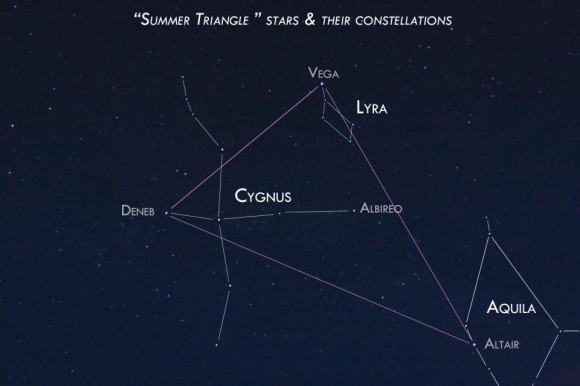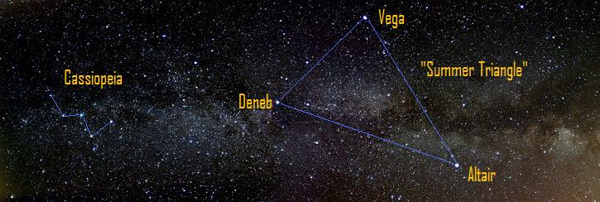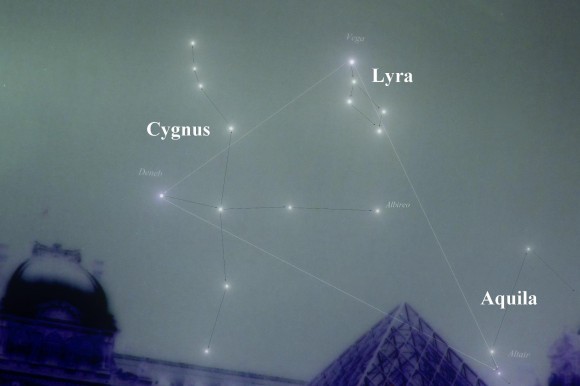
We’ve recently seen Orion’s return to the east before dawn, which means our northern summer is beginning to draw to the a close. But the Summer Triangle asterism still rules the skies. It pops out first thing at nightfall and climbs highest up for the night at late evening. From mid-northern latitudes, Vega – the Summer Triangle’s brightest star – shines high overhead around 10:45 p.m. local daylight saving time (9:45 p.m. local standard time). Altair resides to the southeast (lower left) of Vega, and Deneb lies to Vega’s east (left).
The Summer Triangle is not a constellation. It’s three bright stars in three different constellations, as the wonderful photo below – by Susan Jensen in Odessa, Washington – shows.
Enjoying EarthSky so far? Sign up for our free daily newsletter today!

Here is the Summer Triangle asterism – 3 bright stars in 3 different constellations – as photographed by Susan Jensen in Odessa, Washington.
As the stars drift westward during the night Deneb will swing upward, to replace Vega as the overhead star some two hours later. Of course, the stars aren’t really moving. It’s the Earth’s rotation that causes the stars to move westward during the night, and the sun to go westward during the day.

Great rift of Milky Way passes through the constellation Cassiopeia and the Summer Triangle.Click here for a larger photo
Because the three stars making up the Summer Triangle are 1st-magnitude stars, you can easily see the brilliant Summer Triangle on moonlit nights. However, you need a dark sky free of moonlight to see the great swath of stars known as the Milky Way passing in between the Summer Triangle stars Vega and Altair. The star Deneb bobs in the middle of this river of stars that meanders through the Summer Triangle, arcing across the sky from horizon to horizon. Although every star that you see with the unaided eye is actually a member of our Milky Way galaxy, the term Milky Way often refers to the cross-sectional view of the galactic disk, whereby innumerable far-off suns congregate into a cloudy trail of stars.
Make friends Summer Triangle and its three brilliant stars – Vega, Deneb and Altair – tonight. Mote the great boulevard of stars that streams right through the Summer Triangle on an inky-dark night. That’s actually an edgewise view of the galactic disk.

Summer Triangle and the top of the Louvre Pyramid from EarthSky Facebook friend VegaStar Carpentier in Paris. More about this photo here. Thanks VegaStar!
By the way, you can see the Summer Triangle in the Southern Hemisphere, too – although there do you call it the Winter Triangle? I wonder. South of the equator, people see an upside-down version of tonight’s sky scene, in contrast to our northern perspective. Late tonight, Southern Hemisphere residents will see Altair at the top of the Summer Triangle, and Vega and Deneb sparkling at bottom.
Summer Triangle: Vega, Deneb, Altair
Bottom line: The Summer Triangle asterism can be seen overhead at late evening now. The Summer Triangle is not a constellation. It’s three bright stars in three different constellations. These stars are Vega in the constellation Lyra the Harp, Deneb in the constellation Cygnus the Swan, and Altair in the constellation Aquila the Eagle.
from EarthSky https://ift.tt/1DZT0dT

We’ve recently seen Orion’s return to the east before dawn, which means our northern summer is beginning to draw to the a close. But the Summer Triangle asterism still rules the skies. It pops out first thing at nightfall and climbs highest up for the night at late evening. From mid-northern latitudes, Vega – the Summer Triangle’s brightest star – shines high overhead around 10:45 p.m. local daylight saving time (9:45 p.m. local standard time). Altair resides to the southeast (lower left) of Vega, and Deneb lies to Vega’s east (left).
The Summer Triangle is not a constellation. It’s three bright stars in three different constellations, as the wonderful photo below – by Susan Jensen in Odessa, Washington – shows.
Enjoying EarthSky so far? Sign up for our free daily newsletter today!

Here is the Summer Triangle asterism – 3 bright stars in 3 different constellations – as photographed by Susan Jensen in Odessa, Washington.
As the stars drift westward during the night Deneb will swing upward, to replace Vega as the overhead star some two hours later. Of course, the stars aren’t really moving. It’s the Earth’s rotation that causes the stars to move westward during the night, and the sun to go westward during the day.

Great rift of Milky Way passes through the constellation Cassiopeia and the Summer Triangle.Click here for a larger photo
Because the three stars making up the Summer Triangle are 1st-magnitude stars, you can easily see the brilliant Summer Triangle on moonlit nights. However, you need a dark sky free of moonlight to see the great swath of stars known as the Milky Way passing in between the Summer Triangle stars Vega and Altair. The star Deneb bobs in the middle of this river of stars that meanders through the Summer Triangle, arcing across the sky from horizon to horizon. Although every star that you see with the unaided eye is actually a member of our Milky Way galaxy, the term Milky Way often refers to the cross-sectional view of the galactic disk, whereby innumerable far-off suns congregate into a cloudy trail of stars.
Make friends Summer Triangle and its three brilliant stars – Vega, Deneb and Altair – tonight. Mote the great boulevard of stars that streams right through the Summer Triangle on an inky-dark night. That’s actually an edgewise view of the galactic disk.

Summer Triangle and the top of the Louvre Pyramid from EarthSky Facebook friend VegaStar Carpentier in Paris. More about this photo here. Thanks VegaStar!
By the way, you can see the Summer Triangle in the Southern Hemisphere, too – although there do you call it the Winter Triangle? I wonder. South of the equator, people see an upside-down version of tonight’s sky scene, in contrast to our northern perspective. Late tonight, Southern Hemisphere residents will see Altair at the top of the Summer Triangle, and Vega and Deneb sparkling at bottom.
Summer Triangle: Vega, Deneb, Altair
Bottom line: The Summer Triangle asterism can be seen overhead at late evening now. The Summer Triangle is not a constellation. It’s three bright stars in three different constellations. These stars are Vega in the constellation Lyra the Harp, Deneb in the constellation Cygnus the Swan, and Altair in the constellation Aquila the Eagle.
from EarthSky https://ift.tt/1DZT0dT

Aucun commentaire:
Enregistrer un commentaire